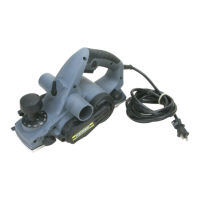Page 6
2. Check the workpiece for nails. If there
are nails, either remove them or set them
well below the intended nished surface.
If the planer blades strike objects like nails
they may cause the tool to kickback, and
serious personal injury may result.
3. Unplug the planer before changing
accessories. Before plugging the tool
in, check that the trigger lock is “OFF”.
Accidental start-ups may occur if planer is
plugged in while changing an accessory.
4. Do not put ngers or any objects into
the chip ejector or clean out chips while
the tool is running. Contact with the blade
drum will cause injury.
5. Never place the planer down until the
blade is completely at rest. Surface contact
with a coasting blade drum may cause the
plane to walk out of control.
6. Never use dull or damaged blades.
Sharp blades must be handled with care.
Damaged blades can snap during use. Dull
blades require more force to push the tool,
possibly causing the blade to break.
7. Always hold the tool rmly with both
hands for maximum control.
8. Never pull the planer backward over
the workpiece. Loss of control may occur.
9. Always wear ear and eye protection
and a breathing mask.
WARNING:
Some dust created by
power sanding, sawing, grinding, drilling
and other construction activities contains
chemicals known to the state of California
to cause cancer, birth defects or other
reproductive harm. Some examples of
these chemicals are:
• Lead from lead-based paints
• Crystalline silica from bricks and
cement and other masonry products,
and
• Arsenic and chromium from chemically-
treated lumber.
Your risk from these exposures varies,
depending on how often you do this type
of work. To reduce your exposure to these
chemical: work in a well ventilated area,
and work with approved safety equipment,
such as those dust masks that are specially
designed to lter out microscopic particles.
SAFETY INSTRUCTIONS

